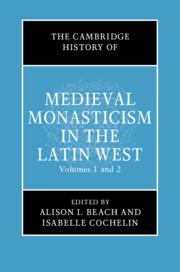Book contents
- The Cambridge History of Medieval Monasticism in the Latin WEST
- The New Cambridge History of Medieval Monasticism in the Latin West
- The Cambridge History of Medieval Monasticism in the Latin WEST
- Copyright page
- Contents
- Figures
- Contributors
- Acknowledgments
- Abbreviations
- 1 General Introduction
- Part I The Origins of Christian Monasticism to the Eighth Century
- Part II The Carolingians to the Eleventh Century
- Part III The Long Twelfth Century
- 34 Historiographical Approaches to Monasticism in the Long Twelfth Century
- 35 Sources for Monasticism in the Long Twelfth Century
- 36 Hermitism in the Eleventh and Twelfth Centuries
- 37 Monastic Theologies, c. 1050–1200
- 38 Monastic Preaching and the Sermon in Medieval Latin Christendom to the Twelfth Century
- 39 The Mass in Monastic Practice: Nuns and Ordained Monks, c. 400–1200
- 40 Reclusion in the Middle Ages
- 41 Similarities and Differences between Monks and Regular Canons in the Twelfth Century
- 42 The Institutionalization of Religious Orders (Twelfth and Thirteenth Centuries)
- 43 Gender and Monastic Liturgy in the Latin West (High and Late Middle Ages)
- 44 Monastic Landscapes
- 45 Later Monastic Economies
- 46 Nobility and Monastic Patronage: The View from Outside the Monastery
- 47 The Medical Role of Monasteries in the Latin West, c. 1050–1300
- 48 East-Central European Monasticism: Between East and West?
- 49 Monasticism, Colonization, and Ethnic Tension in Late Medieval Ireland
- Part IV Forms of Monasticism in the Late Middle Ages
- Index
- References
39 - The Mass in Monastic Practice: Nuns and Ordained Monks, c. 400–1200
from Part III - The Long Twelfth Century
Published online by Cambridge University Press: 16 January 2020
- The Cambridge History of Medieval Monasticism in the Latin WEST
- The New Cambridge History of Medieval Monasticism in the Latin West
- The Cambridge History of Medieval Monasticism in the Latin WEST
- Copyright page
- Contents
- Figures
- Contributors
- Acknowledgments
- Abbreviations
- 1 General Introduction
- Part I The Origins of Christian Monasticism to the Eighth Century
- Part II The Carolingians to the Eleventh Century
- Part III The Long Twelfth Century
- 34 Historiographical Approaches to Monasticism in the Long Twelfth Century
- 35 Sources for Monasticism in the Long Twelfth Century
- 36 Hermitism in the Eleventh and Twelfth Centuries
- 37 Monastic Theologies, c. 1050–1200
- 38 Monastic Preaching and the Sermon in Medieval Latin Christendom to the Twelfth Century
- 39 The Mass in Monastic Practice: Nuns and Ordained Monks, c. 400–1200
- 40 Reclusion in the Middle Ages
- 41 Similarities and Differences between Monks and Regular Canons in the Twelfth Century
- 42 The Institutionalization of Religious Orders (Twelfth and Thirteenth Centuries)
- 43 Gender and Monastic Liturgy in the Latin West (High and Late Middle Ages)
- 44 Monastic Landscapes
- 45 Later Monastic Economies
- 46 Nobility and Monastic Patronage: The View from Outside the Monastery
- 47 The Medical Role of Monasteries in the Latin West, c. 1050–1300
- 48 East-Central European Monasticism: Between East and West?
- 49 Monasticism, Colonization, and Ethnic Tension in Late Medieval Ireland
- Part IV Forms of Monasticism in the Late Middle Ages
- Index
- References
Summary
The earliest monasteries were founded in fourth-century Egypt, Syria, and Palestine as communities of lay men and women, who withdrew to the desert to pursue lives of asceticism and devotion to God. Inspired by the command to “pray without ceasing” (1 Thess. 5:17), early monks and nuns devoted themselves to prayer and the chanting of the Psalms, whether in their cells (in eremitic communities) or in groups (in cenobitic communities). Early monastic liturgy almost certainly drew on the traditions of urban Christian churches, which had begun to develop public prayer rituals following the conversion of Constantine in 312 and the ensuing legalization of Christianity. Evidence for at least six of the eight hours of the medieval divine office can be found in Eastern sources as early as the fourth century. Prayer, the reading of the Scriptures, and the recitation of the Psalms formed the core of early monastic practice. Celebration of the mass—an essential part of monastic life during the high Middle Ages—does not feature prominently in these early sources.
- Type
- Chapter
- Information
- The Cambridge History of Medieval Monasticism in the Latin West , pp. 729 - 746Publisher: Cambridge University PressPrint publication year: 2020

